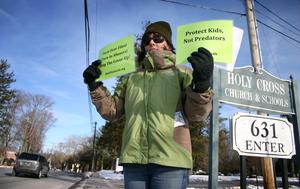By Brian Citino
Dover Post
January 13, 2011
http://www.doverpost.com/communities/x100916654/SNAP-urging-Holy-Cross-sex-abuse-victims-to-step-forward
 |
| Western regional Director of SNAP (Survivors Network of those Abused by Priests) Joelle Casteix holds up signs at the corner of State Street and Scull Terrace on Wednesday, Jan. 13, in protest of the alleged abuse by former and current members of Holy Cross Church. |
Following the release of the Catholic Diocese of Wilmington’s Amended Plan of Reorganization with the U.S. Bankruptcy Court, SNAP, or the Survivors Network of those Abused by Priests, has taken up a presence in the First State in recent days, bringing their message to Dover last week.
Joelle Casteix, western regional director for SNAP, set up outside Church of the Holy Cross the morning of Jan. 13, to draw attention to the accusations that the parish has been home to eight priests accused of sexual abuse in years ranging from 1966 to 2000.
SNAP is demanding full transparency of documents related to alleged sexual abuse cases from the Diocese, as the Amended Plan of Reorganization, released Jan. 10 by the Most Rev. W. Francis Malooly, Bishop of Wilmington, includes a settlement for the 150 victims with pending suits.
Casteix said SNAP wanted to offer sympathy and help parishioners while also urging other victims that have been silent to come forward.
“We have to draw attention to this,” she said. “The public needs to know. I know there are dozens of victims from Holy Cross who feel as if they are alone and need to know they aren’t. And I know there are witnesses out there who don’t know how to come forward.”
Casteix was alone in her short protest, as the other members of SNAP set to join her failed to reach Dover on time due to car trouble.
Bob Krebs, director of the office of communications for the Diocese, did not respond to the specific protest at Holy Cross, but said the diocese has already complied with the other demands of SNAP.
“Information as far as the priests who have had substantiated and collaborated allegations of sexual abuse against them, all that information was already made public by Bishop Saltarelli,” Krebs said. “The diocese has never insisted or asked for any documents not to be released by any of the courts. We are committed to dealing as openly and honestly as possible.”
The accused clerics from Holy Cross include Fr. William E. Irwin, Fr. Richard F. Gardiner, Fr. Carmen D. Vignola, Fr. Leonard J. Mackiewicz, Eugene F. Clarahan, Harry Weaver, Kenneth J. Martin and Fr. Paul D. Calamari.
All but Weaver were named in the late Bishop Michael A. Saltarelli’s 2006 list of 20 priests against whom the Diocese received substantiated allegations of sexual abuse of minors.
A representative from Holy Cross could not be reached for comment.
In the plan released by the Diocese, a sum of $74 million would be paid out to abuse victims, with individual compensation being determined in the courts and ranging from $75,000 to $3 million.
The money will come partially from the Diocese in the form of its insurance, all but $3 million of its unrestricted funds and all of the real estate owned by the diocesan corporation, including the Bishop’s residence. The assets total approximately $30 million.
Non-debtor Catholic entities, such as the Catholic Diocese Foundation, Catholic Cemeteries, Siena Hall, Seton Villa and Seton Home, will contribute cash, real estate and other assets totaling about $69 million, with CDF giving the most at $53 million.
The exchange for the contributors is that they’ll be released from all litigation moving forward.
Beyond the $74 million in the abuse settlement, the remainder of the funds will go toward settling debts with the Diocese’s other creditors.
Even though the compensation to abuse victims is higher on average than settlements in other dioceses in the past, Casteix said the offer still is not satisfying.
She said the reason she visited Delaware, after learning of the plan, is because it was a “slap in the face to survivors” that a full-disclosure of documentation was not part of the settlement.
“The number-one reason that victims are so outraged is because of the institutional secrecy and cover up,” Casteix said. “What we’ve seen in the Catholic Church is that their policy and practice has been to cover up for these guys and shuffle them off to another parish.”
While many predators have been named to date, she said, those who allegedly covered up the abuse are still at large.
With full transparency from the Diocese, Casteix said, those individuals could be identified and further steps could be taken toward preventing future abuse.
“The documents are turned over and then the institutions will be held accountable,” she said. “It’s amazing how quickly abuse is stopped when people are punished for covering it up.”
In the coming months, the plan submitted by the Diocese will go through the bankruptcy court process, and if accepted, should reach a confirmation hearing sometime in April, Diocese attorney Tony Flynn said.
If accepted, Flynn said the Diocesan operations would be scaled down by selling property and making necessary layoffs, and the schools and parishes it oversees would be expected to self-sustain more than they do now.
“In rough terms, it will be a much smaller operation at the Diocesan level,” he said. “There would be budget cutbacks and some reduction of staff.”
In the event that the plan does not pass through, there is a second option, the “Diocese-Only” plan, in which money available to survivors would be limited to the assets of the Diocese alone.
The letter released by Bishop Malolly said under this plan the “estimated total of assets available for distribution could be as little as $15 million” to be “apportioned among all creditors, including abuse survivors and pension beneficiaries.”
Email Brian Citino at brian.citino@doverpost.com
Any original material on these pages is copyright © BishopAccountability.org 2004. Reproduce freely with attribution.